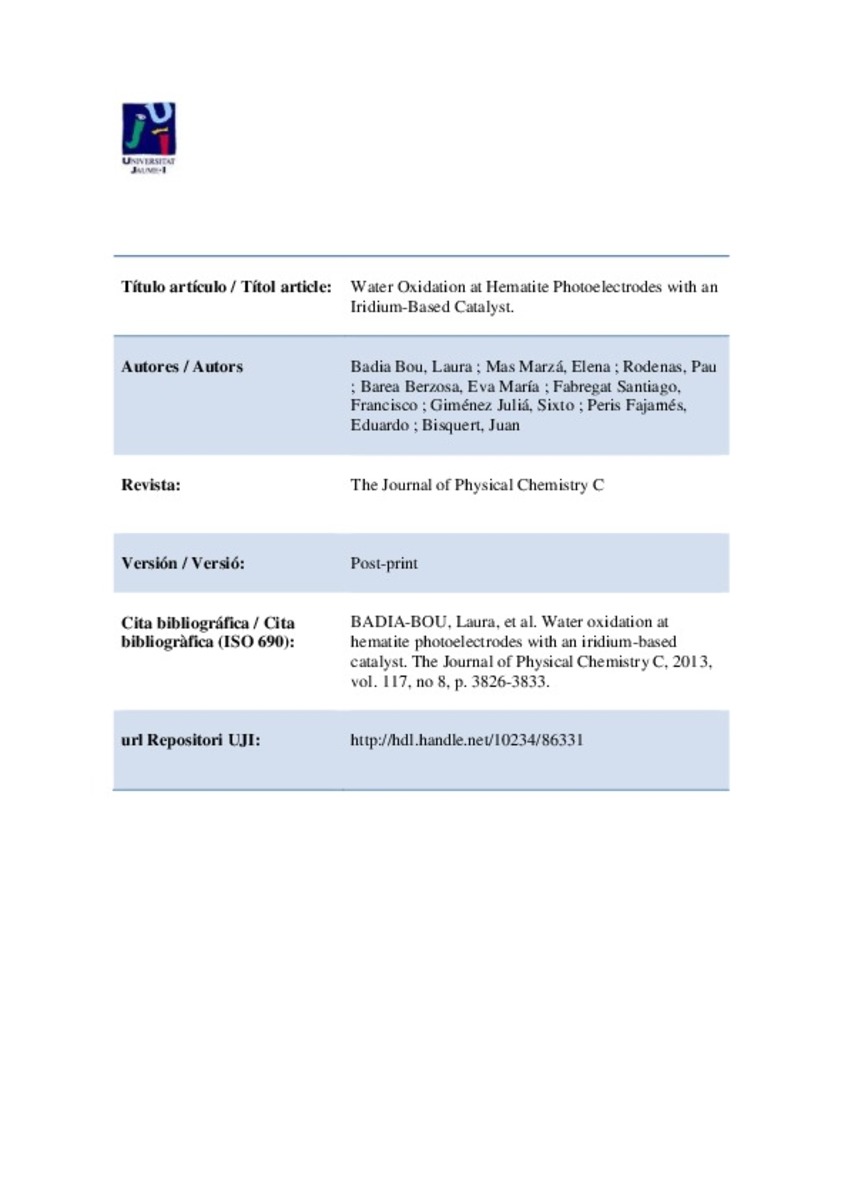Mostrar el registro sencillo del ítem
Water Oxidation at Hematite Photoelectrodes with an Iridium-Based Catalyst
| dc.contributor.author | Badia Bou, Laura | |
| dc.contributor.author | Mas, Elena | |
| dc.contributor.author | Rodenas, Pau | |
| dc.contributor.author | Barea, Eva M | |
| dc.contributor.author | Fabregat-Santiago, Francisco | |
| dc.contributor.author | Gimenez, Sixto | |
| dc.contributor.author | Peris, Eduardo | |
| dc.contributor.author | Bisquert, Juan | |
| dc.date.accessioned | 2014-03-10T13:42:44Z | |
| dc.date.available | 2014-03-10T13:42:44Z | |
| dc.date.issued | 2013 | |
| dc.identifier.citation | Badia-Bou, Laura, Elena Mas-Marza, Pau Rodenas, Eva M. Barea, Francisco Fabregat-Santiago, Sixto Gimenez, Eduardo Peris, and Juan Bisquert. "Water oxidation at hematite photoelectrodes with an iridium-based catalyst." The Journal of Physical Chemistry C 117, no. 8 (2013): 3826-3833. | ca_CA |
| dc.identifier.issn | 1932-7455 | |
| dc.identifier.issn | 1932-7447 | |
| dc.identifier.uri | http://hdl.handle.net/10234/86331 | |
| dc.description.abstract | The iridium complex [Cp*Ir(H2O)3](SO 4) was used as an organometallic source for the electrodeposition of iridium oxide onto Fe2O3. The new iridium-containing electrode allowed us to study the coupling between the photocatalytic properties of hematite and the electrocatalytic properties of the iridium-based material. A cathodic shift of the photocurrent for water oxidation upon electrodeposition of the iridium complex was observed, which increased with increasing surface concentration of IrOx on Fe2O3. The shift for the highest surface concentration of iridium tested amounts to 300 mV at 200 μA·cm-2 current density. The catalytic mechanism of the IrOx layer was unveiled by impedance spectroscopy measurements fitted to a physical model and can be explained on the basis of a highly capacitive layer, which enhances charge separation and stores photogenerated holes at Fe2O3, subsequently oxidizing water. These findings improve our understanding of the mechanism of water oxidation by heterogeneous Ir-based catalysts coupled to semiconductor electrodes | ca_CA |
| dc.description.sponsorShip | J.B. acknowledges support by projects from Ministerio de Economía y Competititvidad (MINECO) of Spain (Consolider HOPE CSD2007-00007) and Generalitat Valenciana (PROMETEO/2009/058). F.F.S. thanks the funding of University Jaume I- Bancaixa (Grant P1·1B2011-50). S.G. acknowledges support by MINECO of Spain under the Ramon y Cajal programme. Mrs. Encarna Blasco from the Instituto Tecnológico de Cerámica is acknowledged for carrying out the structural characterization by XPS. The SCIE of Universidad de Valencia is acknowledged for the SEM images. | ca_CA |
| dc.format.extent | 8 p. | ca_CA |
| dc.language.iso | eng | ca_CA |
| dc.publisher | American Chemical Society | ca_CA |
| dc.relation.isPartOf | The Journal of Physical Chemistry C (2013) 117, no. 8 | ca_CA |
| dc.rights | © 2013 American Chemical Society | ca_CA |
| dc.rights.uri | http://rightsstatements.org/vocab/InC/1.0/ | * |
| dc.subject | Catalytic mechanisms | ca_CA |
| dc.subject | Cathodic shifts | ca_CA |
| dc.subject | Charge separation | ca_CA |
| dc.subject | Electrocatalytic properties | ca_CA |
| dc.subject | Impedance spectroscopy measurement | ca_CA |
| dc.subject | Iridium complex | ca_CA |
| dc.subject | Iridium oxide | ca_CA |
| dc.subject | Photo-electrodes | ca_CA |
| dc.subject | Photocatalytic property | ca_CA |
| dc.subject | Semiconductor electrod | ca_CA |
| dc.subject | Surface concentration | ca_CA |
| dc.subject | Water oxidation | ca_CA |
| dc.title | Water Oxidation at Hematite Photoelectrodes with an Iridium-Based Catalyst | ca_CA |
| dc.type | info:eu-repo/semantics/article | ca_CA |
| dc.identifier.doi | http://dx.doi.org/10.1021/jp311983n | |
| dc.rights.accessRights | info:eu-repo/semantics/openAccess | ca_CA |
| dc.relation.publisherVersion | http://pubs.acs.org/doi/abs/10.1021/jp311983n | ca_CA |
| dc.type.version | info:eu-repo/semantics/acceptedVersion |
Ficheros en el ítem
Este ítem aparece en la(s) siguiente(s) colección(ones)
-
QUIO_Articles [690]
Articles de publicacions periòdiques -
FCA_Articles [501]
Articles de publicacions periódiques







